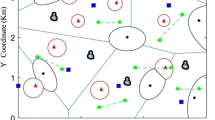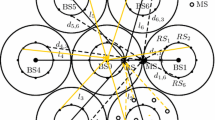Abstract
This paper focuses on the user-pair association for multi-tier relay-based dual-hop heterogeneous networks (HetNets) and proposes a novel min–max user-pair association (MM-UPA) criterion by integrating the bias factors, which is an evolution of conventional single-hop user association based on receive signal strength (RSS). The core idea of the proposed MM-UPA is that, in each tier the nearest relay to a typical user-pair is characterized by the maximum of the RSS reciprocals \({1 / {P_{SR}^{j} }}\) and \({1/ {P_{RD}^{j} }}\) by the source and destination from relay. Then, a typical user-pair is associated to the relay based on minimizing these maximums of each tier. This proposed MM-UPA criterion is fit especially for the relay-based HetNets due to effectively exploiting the source-relay and relay-destination links simultaneously. With the MM-UPA criterion, by using stochastic geometry and homogeneous Poisson point processes, we present the analytical expression of the probability that a typical user-pair is associated with a relay of the kth tier as well as the corresponding statistical description of the distances from the source and destination of a typical user-pair to its associated relay. Finally, the average outage probability of a typical user-pair relay communication link is derived. The presented simulations and numerical results validate the derivations.





Similar content being viewed by others
References
Index, C. V. N. Global mobile data traffic forecast update 2014–2019. White paper c11-520862. http://www.cisco.com/c/en/us/solutions/collateral/serviceprovider/visual-networking-index-vni/white_pape-r_c11-520862.html.
5GPPP. (2016). 5G empowering vertical industries. Technical report.
Wang, C. X., Haider, F., Gao, X., & You, X. H. (2014). Cellular architecture and key technologies for 5G wireless communication networks. IEEE Communications Magazine, 52(2), 122–130.
Kamel, M., Hamouda, W., & Youssef, A. (2016). Ultra-dense networks: A survey. IEEE Communications Surveys and Tutorials, PP(99), 1.
Stoyan, Dietrich. (1987). Stochastic geometry and its applications. New York: Wiley.
Andrews, J. G., Baccelli, F., & Ganti, R. K. (2011). A tractable approach to coverage and rate in cellular networks. IEEE Transactions on Communications, 59(11), 3122–3134.
Hasan, A., & Andrews, J. G. (2007). The guard zone in wireless ad hoc networks. IEEE Transactions on Wireless Communications, 6(3), 897–906.
Liu, D., Wang, L., Chen, Y., Elkashlan, M., Wong, K. K., Schober, R., et al. (2016). User association in 5G networks: A survey and an outlook. IEEE Communications Surveys and Tutorials, 18(2), 1018–1044.
Andrews, J., Singh, S., Ye, Q., Lin, X., & Dhillon, H. (2013). An overview of load balancing in HetNets: old myths and open problems. IEEE Wireless Communications, 21(2), 18–25.
GPP TR 36.912 V2.0.0. (2009). 3GPP; technical specification group radio access network; feasibility study for further advancements for E-UTRA (release 9).
Dhillon, H. S., Ganti, R. K., Baccelli, F., & Andrews, J. G. (2011). Modeling and analysis of k-tier downlink heterogeneous cellular networks. IEEE Journal on Selected Areas in Communications, 30(3), 550–560.
Chen, Y., Li, J., Lin, Z., & Mao, G. (2016). User association with unequal user priorities in heterogeneous cellular networks. In: IEEE Transactions on Vehicular Technology (p. 1).
Khandekar, A., Bhushan, N., Tingfang J., & Vanghi, V. (2010). LTE-advanced: Heterogeneous networks. In IEEE wireless conference (pp. 978–982).
Jo, H. S., Sang, Y. J., Xia, P., & Andrews, J. G. (2011). Heterogeneous cellular networks with flexible cell association: a comprehensive downlink SINR analysis. IEEE Transactions on Wireless Communications, 11(10), 3484–3495.
Jo, H. S., Sang, Y. J., Xia, P., & Andrews, J. G. (2011). Outage probability for heterogeneous cellular networks with biased cell association. In IEEE global telecommunications conference (Vol. 58, pp. 1–5).
Jha, S. C., Sivanesan, K., Vannithamby, R., & Koc, A. T. (2014). Dual connectivity in LTE small cell networks. In: IEEE GLOBECOM workshops (Vol. 16, pp. 1205–1210).
Sekander, S., Tabassum, H., & Hossain, E. (2016). Decoupled uplink-downlink user association in multi-tier full-duplex cellular networks: A two-sided matching game. IEEE Transactions on Mobile Computing, PP(99), 1.
Semiari, O., Saad, W., Valentin, S., Bennis, M., & Maham, B. (2014). Matching theory for priority-based cell association in the downlink of wireless small cell networks. In IEEE international conference on acoustics, speech and signal processing (pp. 444–448).
Jia, X., Fu, H., Yang, L., & Zhao, L. (2015). Superposition coding cooperative relaying communications: outage performance analysis. International Journal of Communication Systems, 24(3), 384–397.
Jia, X., & Yang, L. (2012). Upper and lower bounds of two-way opportunistic amplify-and-forward relaying channels. IEEE Communications Letters, 16(8), 1180–1183.
Jia, X., Yang, L., & Zhu, H. (2014). Cognitive opportunistic relaying systems with mobile nodes: average outage rates and outage durations. IET Communications, 8(6), 789–799.
Ali, M., Qaisar, S., Naeem, M., & Mumtaz, S. (2016). Energy efficient resource allocation in D2D-assisted heterogeneous networks with relays. IEEE Access, 4, 4902–4911.
Al-Hourani, A., Kandeepan, S., & Hossain, E. (2016). Relay-assisted device-to-device communication: a stochastic analysis of energy saving. IEEE Transactions on Mobile Computing, 15(12), 3129–3141.
Mugume, E., & So, D. (2017). User association in energy-aware dense heterogeneous cellular networks. IEEE Transactions on Wireless Communications, PP(99), 1.
David, H. A., & Nagaraja, H. N. (2003). Order statistics (3rd ed.). New York: Wiley.
Gradshteuin, I. S., Ryzhik, I. M., Jeffrey, A., & Zwillinger, D. (2007). Table of integrals, series, and products (7th ed.). San Diego: Academic.
Duong, T. Q., Bao, V. N. Q., & Zepernick, H. J. (2009). On the performance of selection decode-and-forward relay networks over Nakagami-m fading channels. IEEE Communications Letters, 13(3), 172–174.
Acknowledgements
This work was supported by the Natural Science Foundation of China under Grant 61561043, 61861039, 61261015, the Science and technology plan Foundation of Gansu Province of China under Grant 18YF1GA060, the program of improving the scientific research ability of young teachers in Northwest Normal University: “Key technologies of next generation wireless networks”, and by the Foundation Research Funds for the University of Gansu Province: ‘Massive MIMO channels modeling and estimation over millimeter wave band for 5G’.
Author information
Authors and Affiliations
Corresponding author
Additional information
Publisher's Note
Springer Nature remains neutral with regard to jurisdictional claims in published maps and institutional affiliations.
Appendices
Appendix 1: Proof of (15)
With (14), the product term in (14) is written as
where \(y_{j}\) is defined as
Furthermore, the product term of the right hand in (29) can be described in a more tractable form with the help of the identity product given by [27]
From (30) and (31), we can describe (29) by
The product term in (32) is given by
Combining (33) and (32) leads to (15).
Appendix 2: Proof of (19)
For the joint probability \(\Pr \left\{ {R_{SR}^{k} \le x,R_{RD}^{k} \le y,n = k} \right\}\), using the definition \(R_{SD}^{k} = \hbox{max} \left( {\left( {R_{SR}^{k} } \right)_{{}}^{{\alpha_{k} }} ,\left( {R_{RD}^{k} } \right)_{{}}^{{\alpha_{k} }} } \right)\) in (6) and the idea of the proposed MM-UPA criterion we have
where (a) follows from the independence assumption, \(f_{{R_{SR}^{k} ,R_{RD}^{k} }} \left( {u,v} \right)\) is the joint PDF of the RVs \(R_{SR}^{k}\) and \(R_{RD}^{k}\). Then, using the law of statistics [25] and the independence between \(R_{SR}^{j}\) and \(R_{RD}^{j}\), the Eq. (34) is further written as
With the consideration that the CDFs of \(R_{SR}^{j}\) and \(R_{RD}^{j}\) are \(F_{{R_{RD}^{j} (R_{SR}^{j} )}} \left( x \right) = 1 - \exp \left( { - \pi \lambda_{j} x^{2} } \right)\), we have the joint probability
Where the similar argument as in (32) is used, and \(A_{lh}\) and \(B_{lh}\) are defined as
With the independence between \(R_{SR}^{k}\) and \(R_{RD}^{k}\), using Lemma 1 we have the joint CDF of \(R_{SR}^{k}\) and \(R_{RD}^{k}\)
As a result, the joint PDF of \(R_{SR}^{k}\) and \(R_{RD}^{k}\) is given by
Finally, by substituting (37) and (39) into (36) and taking the derivative of \(\Pr \left\{ {R_{SR}^{k} \le x,R_{RD}^{k} \le y,n = k} \right\}{\kern 1pt} {\kern 1pt} {\kern 1pt}\) with respect to \(x\) and \(y\), we have Theorem 2.
Appendix 3: Proof of (26)
Here, we only present the proof for the case \(X_{SR}^{k} \ge Y_{RD}^{k}\). The results for \(X_{SR}^{k} < Y_{RD}^{k}\) are straightforward. With the definition \(SINR_{SR}^{k}\) in (21), by defining the total interference term \(I_{SR}^{k} = \sum\nolimits_{j = 1}^{K} {\sum\nolimits_{{i \in \varPhi_{j} \backslash k}} {P_{S}^{j} h_{{SR_{i} }}^{j} \left( {Y_{{SR_{i} }}^{j} } \right)^{{ - \alpha_{j} }} } }\) we have
where (a) follows from the Rayleigh fading assumption \(h_{SR}^{k} \sim \exp \left( 1 \right)\), (b) follows from the definition of Laplace transform, and \(\mathcal{L}_{{I_{SRj}^{k} }} \left( \cdot \right)\) is the Laplace transform of the RV \(I_{SRj}^{k} = \sum\limits_{{i \in \varPhi_{j} \backslash R}} {P_{S}^{j} h_{{SR_{i} }}^{j} \left( {Y_{{SR_{i} }}^{j} } \right)}^{{ - \alpha_{j} }}\). With the definition \(I_{SRj}^{k}\), we have the Laplace transform
where (b) follows from the mapping theorem. The integral limits of (41) are achieved by the following fact. When the typical user-pair is associated with the preferable relay in the kth tier, the conditions \(X_{SD}^{k} = \hbox{max} \left( {\left( {X_{SR}^{k} } \right)_{{}}^{{\alpha_{k} }} ,\left( {Y_{RD}^{k} } \right)_{{}}^{{\alpha_{k} }} } \right)\) and \(\frac{1}{{P_{R}^{k} L_{0} \beta_{k} r_{0}^{{\alpha_{k} }} }}X_{SD}^{k} < \frac{1}{{P_{R}^{j} L_{0} \beta_{j} r_{0}^{{\alpha_{j} }} }}\hbox{max} \left( {\left( {R_{SR}^{j} } \right)_{{}}^{{\alpha_{j} }} ,\left( {R_{RD}^{k} } \right)_{{}}^{{\alpha_{j} }} } \right)\) should be always satisfied. Since we consider the case \(X_{SR}^{k} \ge Y_{RD}^{k}\), it is achieved that \(\frac{1}{{P_{R}^{k} \beta_{k} r_{0}^{{\alpha_{k} }} }}\left( {X_{SR}^{k} } \right)_{{}}^{{\alpha_{k} }} < \frac{1}{{P_{R}^{j} \beta_{j} r_{0}^{{\alpha_{j} }} }}\left( y \right)_{{}}^{{\alpha_{j} }}\) and the lower bound of \(y\) can be given by \(Z_{1} = \left( {\widehat{P}_{R}^{j} \widehat{\beta }_{j} } \right)^{{\frac{1}{{\alpha_{j} }}}} r_{0}^{{1 - \frac{{\alpha_{k} }}{{\alpha_{j} }}}} \left( {X_{SR}^{k} } \right)^{{\frac{{\alpha_{k} }}{{\alpha_{j} }}}}\). Using the variable transformation \(u = \left( {\frac{{P_{S}^{j} }}{{P_{S}^{k} }}\left( {X_{SR}^{k} } \right)^{{\alpha_{k} }} \tau } \right)^{{ - \frac{2}{{\alpha_{j} }}}} y^{2}\) leads to (41) given by
where \(Z_{2} = \left( {\widehat{P}_{R}^{j} \widehat{\beta }_{j} } \right)^{{\frac{2}{{\alpha_{j} }}}} r_{0}^{{2 - \frac{{2\alpha_{k} }}{{\alpha_{j} }}}} \left( {\frac{{P_{S}^{j} }}{{P_{S}^{k} }}\tau } \right)^{{ - \frac{2}{{\alpha_{j} }}}}\). The Eq. (42) can be further written as
where \(Z_{3} = Z_{2}^{{\frac{{\alpha_{j} }}{2}}} = \left( {\widehat{P}_{R}^{j} \widehat{\beta }_{j} } \right)r_{0}^{{\alpha_{j} - \alpha_{k} }} \left( {\frac{{P_{S}^{j} }}{{P_{S}^{k} }}\tau } \right)^{ - 1}\), by using (3. 194.2) in [26] we have
Similarly, for the probability \(\Pr \left\{ {SINR_{RD}^{k} > \tau } \right\}\) we have
where \(I_{RDj}^{k} = \sum\nolimits_{{i \in \varPhi_{j} \backslash k}} {P_{R}^{j} h_{{R_{i} D}}^{j} \left( {Y_{{R_{i} D}}^{j} } \right)^{{ - \alpha_{j} }} }\). The Laplace transformation \(\mathcal{L}_{{I_{RDj}^{k} }} \left( {\left( {P_{R}^{k} } \right)^{ - 1} \left( {Y_{RD}^{k} } \right)^{{\alpha_{k} }} \tau } \right)\) is
Obviously, \(Z_{4} = \left( {\frac{{P_{R}^{j} }}{{P_{R}^{k} }}\left( {Y_{RD}^{k} } \right)^{{\alpha_{k} }} \tau } \right)^{{ - \frac{2}{{\alpha_{j} }}}} \left( {\widehat{P}_{R}^{j} \widehat{\beta }_{j} } \right)^{{\frac{2}{{\alpha_{j} }}}} r_{0}^{{2 - 2\frac{{\alpha_{k} }}{{\alpha_{j} }}}} \left( {X_{SR}^{k} } \right)^{{\frac{{2\alpha_{k} }}{{\alpha_{j} }}}} = \left( {\frac{{X_{SR}^{k} }}{{Y_{RD}^{k} }}} \right)^{{\frac{{2\alpha_{k} }}{{\alpha_{j} }}}} \left( \tau \right)^{{ - \frac{2}{{\alpha_{j} }}}} \left( {\widehat{\beta }_{j} } \right)^{{\frac{2}{{\alpha_{j} }}}} r_{0}^{{2 - 2\frac{{\alpha_{k} }}{{\alpha_{j} }}}}\), and \(Z_{5} = \left( {\frac{{X_{SR}^{k} }}{{Y_{RD}^{k} }}} \right)^{{\alpha_{k} }} \left( \tau \right)^{ - 1} \left( {\widehat{\beta }_{j} } \right)r_{0}^{{\alpha_{j} - \alpha_{k} }}\).
Finally, with the substitution of (47), (45), (44), (40) into (25), we have (27). With the similar argument line, the result (28) can be achieved for the case \(X_{SR}^{k} < Y_{RD}^{k}\).
Rights and permissions
About this article
Cite this article
Jia, X., Xu, W., Xie, M. et al. Min–Max User-Pair Association Criterion and Outage Performance of K-Tier Relay-Based Heterogeneous Networks. Wireless Pers Commun 104, 149–171 (2019). https://doi.org/10.1007/s11277-018-6013-x
Published:
Issue Date:
DOI: https://doi.org/10.1007/s11277-018-6013-x




